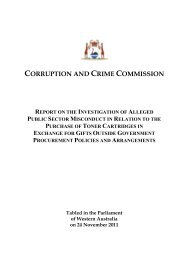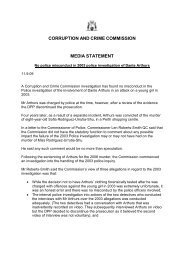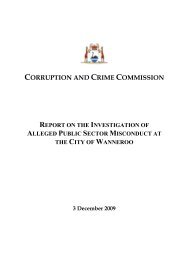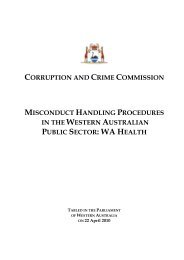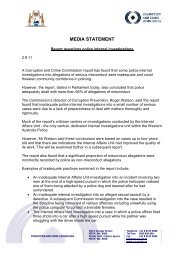DPI: Misconduct by Authorised Vehicle Examiners - Corruption and ...
DPI: Misconduct by Authorised Vehicle Examiners - Corruption and ...
DPI: Misconduct by Authorised Vehicle Examiners - Corruption and ...
Create successful ePaper yourself
Turn your PDF publications into a flip-book with our unique Google optimized e-Paper software.
The weighing up <strong>and</strong> comparison of the likelihood of the existence of<br />
competing facts or conclusions. A fact is proved to be true on the<br />
balance of probabilities if its existence is more probable than not, or if<br />
it is established <strong>by</strong> a preponderance of probability ... 15<br />
[64] The balance of probabilities is a st<strong>and</strong>ard used <strong>by</strong> courts when<br />
considering civil matters. It is a st<strong>and</strong>ard which is less than the criminal<br />
st<strong>and</strong>ard of beyond reasonable doubt. This was confirmed <strong>by</strong> the High<br />
Court in a unanimous judgement in Rejfek v McElroy (1965) 112 CLR 517:<br />
… The difference between the criminal st<strong>and</strong>ard of proof <strong>and</strong> the civil<br />
st<strong>and</strong>ard of proof is no mere matter of words: it is a matter of critical<br />
substance. No matter how grave the fact which is to be found in a civil<br />
case, the mind has only to be reasonably satisfied <strong>and</strong> has not with respect<br />
to any matter in issue in such a proceeding to attain that degree of certainty<br />
which is indispensable to the support of a conviction upon a criminal<br />
charge …<br />
[65] The balance of probabilities can be applied to circumstantial evidence, as<br />
explained <strong>by</strong> the High Court in Luxton v Vines (1952) 85 CLR 352:<br />
… The difference between the criminal st<strong>and</strong>ard of proof in its application to<br />
circumstantial evidence <strong>and</strong> the civil is that in the former the facts must be<br />
such as to exclude reasonable hypotheses consistent with innocence, while<br />
in the latter you need only circumstances raising a more probable inference<br />
in favour of what is alleged. In questions of this sort, where direct proof is<br />
not available, it is enough if the circumstances appearing in evidence give<br />
rise to a reasonable <strong>and</strong> definite inference: they must do more than give<br />
rise to conflicting inferences of equal degrees of probability so that the<br />
choice between them is mere matter of conjecture … But if circumstances<br />
are proved in which it is reasonable to find a balance of probabilities in<br />
favour of the conclusions sought then, though the conclusion may fall short<br />
of certainty, it is not to be regarded as a mere conjecture or surmise …<br />
[66] The degree of evidence necessary to reach a conclusion on the balance of<br />
probabilities varies according to the seriousness of the issues involved.<br />
This was explained <strong>by</strong> Sir Owen Dixon in Briginshaw v Briginshaw (1938)<br />
60 CLR 336:<br />
… Except upon criminal issues to be proved <strong>by</strong> the prosecution, it is<br />
enough that the affirmative of an allegation is made out to the reasonable<br />
satisfaction of the tribunal. But reasonable satisfaction is not a state of<br />
mind that is attained or established independently of the nature <strong>and</strong><br />
consequence of the fact or facts to be proved.<br />
The seriousness of an allegation made, the inherent unlikelihood of an<br />
occurrence of a given description, or the gravity of the consequences<br />
flowing from a particular finding are considerations which must affect the<br />
answer to the question whether the issue has been proved to the<br />
reasonable satisfaction of the tribunal. In such matters “reasonable<br />
satisfaction” should not be produced <strong>by</strong> inexact proofs, indefinite testimony,<br />
or indirect inferences …<br />
13




